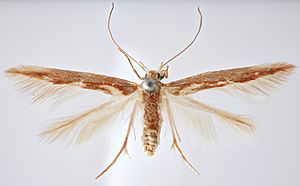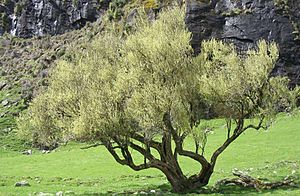Stathmopoda campylocha facts for kids
Quick facts for kids Stathmopoda campylocha |
|
|---|---|
 |
|
| Conservation status | |
 Nationally Critical (NZ TCS) |
|
| Scientific classification | |
| Kingdom: | |
| Phylum: | |
| Class: | |
| Order: | |
| Family: |
Stathmopodidae
|
| Genus: |
Stathmopoda
|
| Species: |
S. campylocha
|
| Binomial name | |
| Stathmopoda campylocha Meyrick, 1889
|
|
Stathmopoda campylocha is a tiny moth that belongs to the family Stathmopodidae. This special moth lives only in New Zealand, meaning it is endemic to that country. Sadly, it is considered "critically endangered" by the Department of Conservation, which means it's at a very high risk of disappearing forever.
Contents
Discovering the Stathmopoda campylocha Moth
This moth was first officially described in 1889 by a scientist named Edward Meyrick. He studied moths he found in places like Wellington and Dunedin in New Zealand. The main example specimen, called the "type specimen," is kept safe at the Natural History Museum, London.
What Does This Moth Look Like?
The Stathmopoda campylocha moth is quite small, usually about 12 to 14 millimeters long. That's roughly half an inch! Its head and body are a pale, shiny yellowish color. The front wings are long and narrow, widest near the base, and come to a sharp point. They are also a pale yellowish color. The back wings are a darker gray.
Where Does This Moth Live?
This moth is found only in New Zealand. In the past, it was seen in areas like Wellington and Dunedin. Over the years, other sightings were made in places such as Silverstream near Upper Hutt and in the Pohangina Forest Reserve. More recently, these moths have been found in different parts of Otago, including the Matukituki Valley.
Moth Habitat and Lifestyle
Scientists who studied Stathmopoda campylocha found them living in forests. This suggests that these moths prefer to make their homes among trees and plants in forest environments.
What Plants Do These Moths Need?
In 2000, a scientist named Brian H. Patrick made an important discovery. He found that Stathmopoda campylocha is closely connected to a plant called Olearia hectorii. This plant itself is also endangered!
Scientists think the moth's young, called larvae, might eat dead plant material (making them detritivores). Another idea is that they might eat tiny bugs called scale insects that live on the plants. Other plants that might also be important for this moth include Olearia fimbriata, Olearia lineata, Olearia bullata, Olearia fragrantissima, and Olearia virgata.
Why Is This Moth Endangered?
Back in 1939, people already knew that Stathmopoda campylocha was extremely rare. Today, its conservation status is "Nationally Critical" under the New Zealand Threat Classification System. This means it is one of the most endangered species in New Zealand and needs urgent help to survive. Protecting its forest homes and the special Olearia hectorii plant is very important for the future of this tiny moth.


